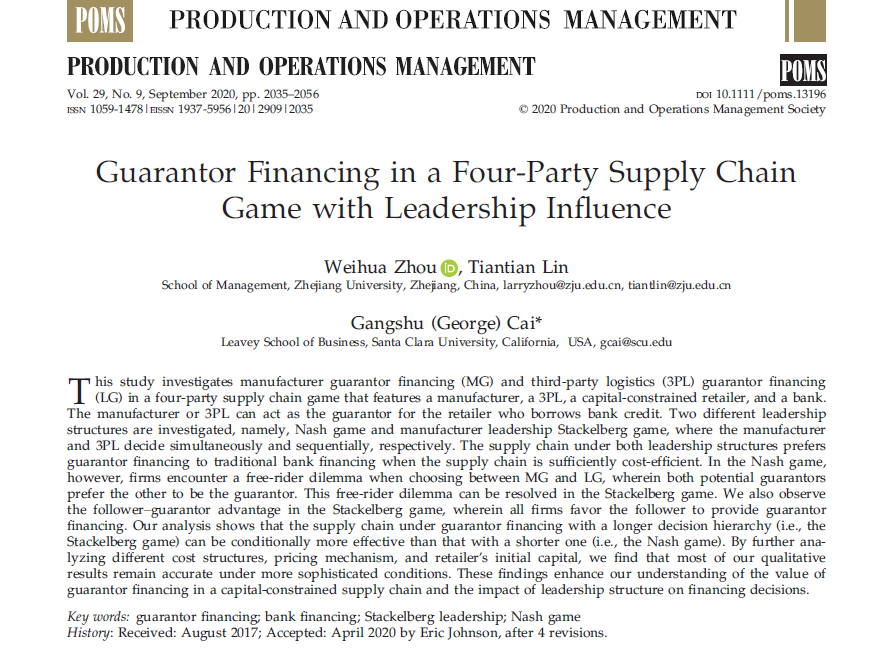In the face of serious financing problems, supply chain partners either directly provide credit or assist enterprises to obtain loans from banks, to be more involved in enterprise financing, which is the "Supply Chain Finance" that we often hear now. When supply chain finance has become an important financing mode for enterprises, under what circumstances should the downstream enterprises with insufficient funds obtain financing services from the upstream enterprises of the supply chain? If more than one supply chain upstream enterprise can provide supply chain financing service, which side should provide it to benefit the supply chain and its members better?
In May 2020, Prof. ZHOU Weihua and his doctoral student LIN Tiantian, together with Prof. CAI Gangshu from Santa Clara University, published an article entitled "Guarantor Financing in a Four-Party Supply Chain Game with Leadership Influence" in Production and Operation Management (one of UTD 24 journals of management), which is among the worlds top journals. The paper constructs a game model including manufacturers, third-party logistics, retailers and banks, and applies game theory and optimization theory to solve the problems. The research conclusion is refined through further analysis, and numerical experiments are carried out to verify the derived results.

Screenshot of printed journal publication (Note: online journal publication was in May 2020, and printed journal publication was in September 2020)
The paper points out that when the operation cost of supply chain enterprises is low, the upstream enterprises can provide financing services for downstream retailers, which can create more profits for all members in the supply chain. However, when the operation efficiency of the supply chain is not high or the supply chain risk is high, the financing service should not be provided by the upstream enterprises of the supply chain, but from the financial institutions outside the supply chain. In addition, the paper further explains that when there are several upstream enterprises in the supply chain that can provide financing services, the downstream enterprises that lack capital should choose the relatively weak side in the upstream enterprises of the supply chain, rather than the strong side, to obtain financing. This can avoid the strong ones squeezing the profits of other members of the supply chain by providing supply chain financing services, which damages the overall efficiency. Surprisingly, the Paper also finds out that all members of the supply chain, including the relatively weak members themselves, prefer to provide supply chain financing services by the weak sides. This is because the upstream vulnerable side can not only increase the sales volume of the main business, but also obtain additional financial service income by providing financing services. Moreover, these benefits will exceed the supply chain risk they undertake. Under this circumstance, the upstream strong sides can improve the main business income without taking any risks; the downstream enterprises lacking capital can obtain financing services at a lower interest rate to obtain better returns as well. The results show that there is an optimal stable arrangement in the supply chain when there are multiple upstream enterprises providing financing services.
As the first paper to explore the participation of multiple member enterprises in supply chain financing services, the research of the team has an important theoretical and practical significance. It not only puts forward that "Supply chain member enterprises not only obtain positive profit utility, but also face negative risk utility when providing financing services" for the first time, but also analyzes the performance of two kinds of utility under different operation configuration and decision-making situations. The results have great reference value for supply chain finance practice, and can better exert the role of supply chain member enterprises and financial institutions in supply chain financing services.